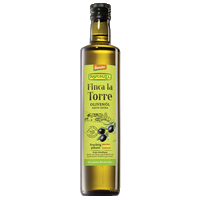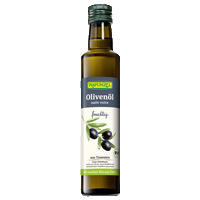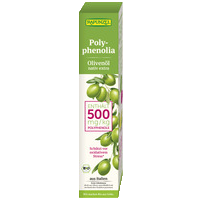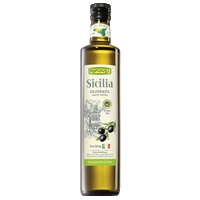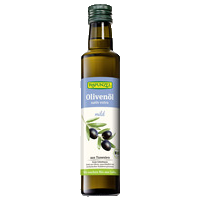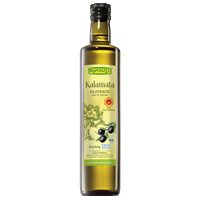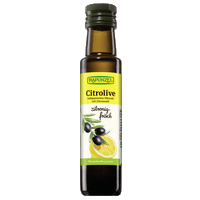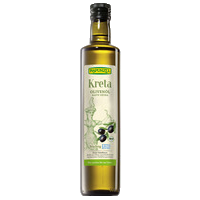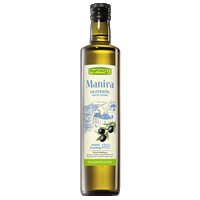Rapunzel Products Oils, fat and vinegar Olive-Oils
Olive oil - epitome of Mediterranean eating culture
Today, many different kinds of olive oil are available - but not every olive oil is the same. Many factors decide about the quality and the taste of olive oil - the soil where the olive trees grow, the maintenance of the olive groves, the climate during the growing season and during harvest, the choice of the best harvest time and the pressing of the olive oil.
The Mediterranean region is characterized by the olive tree. Nearly half of the 750 - 800 million olive trees worldwide are found there. The moderate climate with abundant sunshine and frequent rain in the winter let the olive trees thrive.
The Mediterranean region is characterized by the olive tree. Nearly half of the 750 - 800 million olive trees worldwide are found there. The moderate climate with abundant sunshine and frequent rain in the winter let the olive trees thrive.
Olive trees have roots that may reach up to 6 meters down into the soil. Therefore, the trees can thrive even in the poorest of soils and during very dry summers. With good maintenance, olive trees can become several hundred years old. Depending on variety, climate, soil and tree maintenance, an olive tree produces its first olives after 4-10 years.
An adult tree produces an average annual yield of 25-30 kg of olives which corresponds to about 4 liters of olive oil. Some of Rapunzel's Greek olive farmers remember particularly good harvest years when one adult tree produced up to 50 kg of olives.
An adult tree produces an average annual yield of 25-30 kg of olives which corresponds to about 4 liters of olive oil. Some of Rapunzel's Greek olive farmers remember particularly good harvest years when one adult tree produced up to 50 kg of olives.
Diligent cultivation, harvest and gentle pressing
Time of harvest
The best time to harvest olives is from fall to winter shortly before the olives have reached full maturity. The olives that are used for olive oil production are harvested in most regions between November and January. Our olive growers determine the time of harvest very diligently in order to recover top-quality oil.
Transport
Not only the harvest time is decisive for the quality of the oil but also the state in which the olives arrive in the oil mill. The olives should be harvested as gently as possible and it must be ensured that the fruit stay mostly undamaged. Furthermore, it is positive for the oil quality if the olives are processed within 24 hours after harvest.
Oil pressing
In the oil mills, the olives are washed, crushed and pressed. All Rapunzel olive oils are produced by means of cold extraction and/or cold pressing at temperatures that do not exceed 27° Celsius. This ensures that almost all of the valuable olive substances that determine the taste, fragrance, color and the vitamin content are preserved.
Oil and fruit juice are separated by centrifugation. The remaining fine pulp particles in the oil are removed by filtration. All Rapunzel olive oils have the "extra virgin" standard which is the highest quality standard for olive oil.
Diverse flavors
Tastes are different
Similar to wine, olive oil has a very versatile taste range. The taste is influenced by the climate, the soil, the origin where the olives come from, the location of the olive grove and the olive variety.
Fruity, pungent oils are made with young, green olives. Harvesting green olives before they have reached their highest degree of maturity yields significantly less oil compared to fully ripe olives. The oil from premature green olives, however, keeps for a longer time and has higher concentrations of valuable plant substances such as polyphenols.
The smell
When you open a bottle of good-quality olive oil you will get a fresh and pleasant smell that may remind you of a freshly mowed spring meadow, of green olives or even of artichokes.
Unwanted aromas are smells that trigger associations with hay, wine or vinegar. These smells may develop if the olives were not processed directly after the harvest and started to ferment before pressing.
The color
The olive oil color is influenced by chlorophyll, by degradation products of chlorophyll and by carotenes. The greener the oil color, the fresher the oil. The degree of maturity of the processed olives plays an important role for the taste and the quality of the olive oil.
Green olives contain a lot of chlorophyll and they make a green, fresh olive oil that has a significantly different quality than carotene-containing, golden yellow olive oil.
The taste: different quality classes with special flavors
Just as the smell of different olive oil qualities varies, olive oil from different quality classes also has different flavors.
Positive signs for a good olive oil are fresh, green and floral notes. This includes the flavor of almost ripe green olives, bananas or green apple. But also aromas such as avocado, citrus fruit, onion and fig or nutty aromas that ressemble the flavor of almonds or pines are a desirable sign of good quality.
Poor quality olive oil is characterized by dry, smoked or fermented flavors that may ressemble hay, vinegar, bacon or caramel tastes. Unwanted flavors are caused by improper olive handling and fermentative processes when the olives are pressed or extracted.
Positive signs for a good olive oil are fresh, green and floral notes. This includes the flavor of almost ripe green olives, bananas or green apple. But also aromas such as avocado, citrus fruit, onion and fig or nutty aromas that ressemble the flavor of almonds or pines are a desirable sign of good quality.
Poor quality olive oil is characterized by dry, smoked or fermented flavors that may ressemble hay, vinegar, bacon or caramel tastes. Unwanted flavors are caused by improper olive handling and fermentative processes when the olives are pressed or extracted.
Oil that is made with young, green olives has a clearly bitter and pungent taste. The EU regulation 640/2008 defines bitterness and spiciness as well as fruity flavors as positive properties of olive oil. These flavors determine the character of a good extra virgin olive oil.
The peppery pungency of very fresh olive oil that may cause a slight cough is a quality marker and a sign for high polyphenol concentrations. The spiciness, however, will diminish over time.
If olive oil is too spicy for you, you should store the oil for several weeks or months until its taste has neutralized. Every olive oil gets milder over time.
The peppery pungency of very fresh olive oil that may cause a slight cough is a quality marker and a sign for high polyphenol concentrations. The spiciness, however, will diminish over time.
If olive oil is too spicy for you, you should store the oil for several weeks or months until its taste has neutralized. Every olive oil gets milder over time.
Since not all customers appreciate pronounced fruity and bitter flavors and since many prefer mild olive oil for various purposes, the Rapunzel olive oil range also includes products with less intense bitterness and spiciness.
The Rapunzel olive oil mild extra virgin for example, is manufactured using the same principles. For this mild-tasting oil, we use selected, extra mild olive varieties from Tunisia.
The Rapunzel olive oil mild extra virgin for example, is manufactured using the same principles. For this mild-tasting oil, we use selected, extra mild olive varieties from Tunisia.
Olive oils
Frequenty asked questions concerning olive oil
Which acids are found in olive oil?
This question refers to the concentration of free fatty acids, expressed as oleic acid. This concentration is an important factor for evaluating the quality of olive oil.
For olive oil extra virgin, the legally determined maximum value amounts to 0.8 g / 100 g oil. A smaller concentration of free oleic acid indicates a perfect degree of maturity and the immediate processing of the olives. That's why the right harvesting time and the direct and careful processing of the olives are decisive factors for top quality.
Can I use olive oil for frying?
Virgin olive oil can be used for the preparation of cold meals such as salads, marinated foods but also for gentle frying, steaming and cooking at temperatures not exceeding 180°C.
Should olive oil have a bitter or scratchy taste?
Yes. Virgin olive oil could also have a well-balanced bitter and spicy taste.
Is unfiltered olive oil better?
Since enzymes in the turbid olive oil portion degrade high-quality oil ingredients, experts recommend to filter the oil. Freshly pressed, unfiltered olive oil is a true delicacy, but should be used up quickly.
Why does refrigerated olive oil form smudges or white crystals?
Rapunzel olive oil has high concentrations of natural ingredients. These secondary plant substances also include waxes that may precipitate as flakes or streaks during refrigeration. When stored at room temperature, the precipitation will dissolve again after 1-2 days.
We consciously avoid the so-called "winterization" (filtration of olive oil at temperature < 8°C). Other secondary plant substances indicate the original character of the oil.

